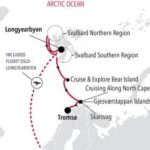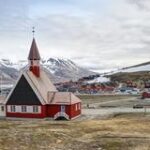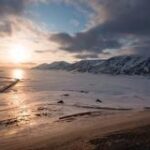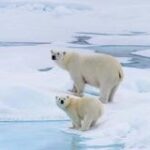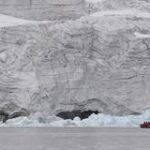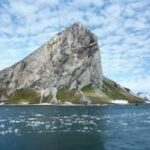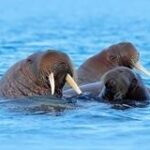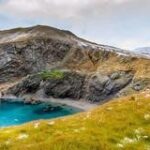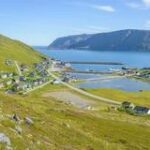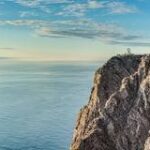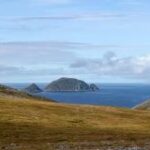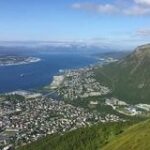JGT’S ARCTIC EXPEDITION JUNE 2024
JGT’s Expedition to the Arctic
24 June 2025 from €8,330pps.
LONGYEARBYEN TO TROMSØ EXPEDITION CRUISE
10 nts ABOARD EXPEDITION SHIP “SILVER WIND”
Tuesday, 25 June Dublin to Oslo
Your limousine will collect you from your front door and take you to the airport for your direct flight to Oslo. Overnight at the Radisson Blu Hotel at Olso Airport.
Wednesday, 26 June Longyearbyen
This morning, check out of your hotel and stroll to the airport. Take your charter flight from Olso to Longyearbyen. This is the biggest settlement in Svalbard. Seat of the Norwegian administration, it also has the best services and infrastructure in the archipelago. Located deep in the Adventfjord, a sidearm of the Isfjorden (Icefjord), Longyearbyen’s airport can be used all-year round, but its harbor is blocked by ice in winter. Most shops, hotels, restaurants and a hospital are within easy walking distance of the port. One of the most prominent buildings in town is the UNIS center, where several Norwegian universities have joined forces to operate and offer the northernmost higher education to both Norwegian and international students. Adjacent to UNIS, and well worth a visit, is the Svalbard Museum, covering the natural history and exploitation of Svalbard. Remnants of the former mining activity can be seen all around Longyearbyen and even in town. Embark the ship and depart at 16:00.
Thursday 27 June, Friday 28 June & Saturday 29 June – Northern Svalbard
Svalbard’s northern region is less influenced by the Norwegian Current coming through the Greenland Sea than the southern region and shows more ice. The northern part of the island of Spitsbergen shows quite a number of impressive fjords, bays and glaciers. The Nordaust Svalbard Nature Reserve includes Spitsbergen’s east coast, the Hinlopen Strait, Nordaustlandet and some islands further east like Kvitoya and Storoya. Several walrus haul-outs, spectacular glaciers, bird cliffs and bird islands, as well as surprising flora in Arctic deserts and the possibility to see polar bears and to visit historically important sites make this an area prone for exploration. Ice conditions will dictate which sites can be seen.
Sunday 30 June, Monday 1 July & Tuesday 2 July – Southern Svalbard
Svalbard’s Southern Region and specifically Spitsbergen’s west coast is less ice-clogged than the rest of Svalbard due to the moderating influenced of the Gulf Stream. Several fjords cut into the western coast of Spitsbergen and have been used by trappers and hunters, as well as the different mining companies that tried to exploit the riches of the archipelago’s largest island of Spitsbergen. Remains of huts and mines, as well as active commercial and scientific settlements can be found and visited. Depending on the time of the season, glaciers can be visited on foot or by sea. Hornsund will reveal fascinating views of geological formations, craggy mountains, spectacular glaciers and a variety of seabirds and seals.
Wednesday 3 July – Bear Island 0630 – 13:00
Bear Island is considered Svalbard’s southernmost island, roughly half way between Spitsbergen and Norway’s North Cape. Although the last polar bears were seen in 2004, the name goes back to Dutch explorer Willem Barentsz and his visit in 1596. The island has been used to hunt walrus, for whaling, and even coal mining has taken place. The strategic location on the border of the Norwegian Sea and the Barents Sea has led to a meteorological station being set up by Norway near Gravodden on Bear Island’s north coast. Some two thirds of the island is a relatively flat plain with shallow freshwater lakes and Ramsar Wetland, while the entire island and the surrounding waters are a Nature Reserve. Bear Island has also been designated an Import Bird Area as it is a staging area for Pink-footed and Barnacle Geese and the steep cliffs south of Sørhamna are home to thousands of breeding seabirds. This is a specially protected area where Zodiacs are allowed to cruise along the cliffs around Kapp Kolthoff. In smaller amounts Atlantic Puffins, Northern Gannets, Glaucous Gulls and Great Skuas are found in between the large Black-legged Kittiwake, Little Auk, Common Guillemot and Brünnich’s Guillemot colonies. The constant battering of the sea has not only created impressive sea caves and tunnels, but unfortunately the Russian vessel Petrozavodsk shipwrecked near Revdalen at the base of the limestone cliffs and the waves are causing a continuous disintegration of the remains of the ship.
Thursday 4 July – Skarsvag 06:00 – 11:30
For those who like to travel far (very far) off the beaten track, then you have found your Nordic nirvana in Skarsvag. Large, sparsely populated (there are just 60 human year round residents), and a joy to all those who revel in stark, unbridled beauty, Skarsvag also enjoys the auspicious title of being the world’s most northerly fishing village. But rolling hills, prolific birdlife and arctic fjords aside, Skarsvag is above all famous for its proximity to the North Cape. Found on the island of Magerøya, the most northernmost point of Europe above the arctic circle is a bucket list basic. Stand beneath the massive metal globe and gaze out onto the Barents Sea, where the only land between you and the North Pole is the Svalbard archipelago. This is truly the land of the midnight sun – in fact, you are so far north that the sun doesn’t even dip beneath the horizon between May and mid-July. The island’s famous bird cliffs are quite spectacular, and home to thousands of puffins, gannets and cormorants. Those willing to hike to cape Knivskjellodden, the northernmost point on Magerøya, will be rewarded with stunning cliff face views of the North Cape Plateau. Before leaving, head into the impressive North Cape Hall for exhibitions on the North Cape’s history. Travellers have been visiting since 1664, when Italian priest Francesco Negri arrived, so there are some tales to tell! More intriguingly, a tunnel has been hewn into the rock, leading down to the cliff face, complete with a chapel.
Northern Cape 12:30 – 12:30
Situated at the very north tip of Norway and inside the Arctic Circle, there is something very special about being (almost) at the top of the world. Called the northernmost point of Europe, the North Cape (Nordkapp in Norwegian) lies about 1,306.3 mi from the North Pole, with no dry land between except for the Svalbald archipelago. Home to where the Atlantic and Arctic oceans meet, this is the true land of the midnight sun – constant spectacular scenic views and 24-hour sunlight lends itself to a sense of giddy informality aboard. Just imagine sipping a chilled glass of champagne at the very top of the world in full daylight at midnight – sensational. Be sure to be on the lookout for hundreds of thousands of puffins, gannets, cormorants, seals, dolphins and whales that make this stretch of chilly water their home. Not forgetting the colourful, compact fishing villages, so at odds with the otherwise this stark, barren landscape.
Thursday 4 July – Gjesværstappan Islands 14:00 – 19:00
Home more than a million birds that perch atop its cliffs, the Gjesværstappan islands are a marvel of nature. Gjesværstappan is a grouping of nearly one hundred islands and rocks, mostly high, steep-sided islands covered in grass that is nearly covered by seabirds. These islands were designated as a nature reserve in 1983 due to their importance as nesting grounds for many species of seabirds, some of them endangered. A birdwatcher’s paradise, Gjesværstappan is noted as one of the more easily-accessed nesting areas inEurope for viewing Atlantic seabirds. It is comprised of several particularly large, tall islands, including Storstappan (rising 283 meters, or 928 feet, out of the sea), Kjerkestappen (166 meters or 545 feet) and Bukkstappen (92 meters, 302 feet). On Storstappan alone, more than one million nesting birds have been counted, and visitors are not allowed to set foot here between June and August to protect its activity as a nesting and breeding ground. The islands of Gjesværstappan are home to one of the most important colonies of Atlantic Puffins in Norway. Other birds that visitors may see include White-tailed Eagles, Arctic Skuas, Common Eider Ducks, Razorbills, Guillemots (black and common), Great Cormorants, Gannets and other species. Tour the islands from a small water craft (kayak or Zodiac) and prepare to be amazed at the splendor of the dramatic cliffs rising from the sea, vibrant and positively teeming with birdlife.
Friday 5 July – Tromso Arrive 08:00
Located in the far north of Norway, a visit to Tromso beckons you to the extremes of this magical country, to explore a fairytale land of jagged mountains, glistening glaciers and husky-pulled sledges. Despite its remote location, you’ll discover a perhaps surprisingly cosmopolitan city, with a healthy student population injecting plenty of energy. Sat 250 miles above the Arctic Circle – at 69° north – you can bathe in the midnight sun’s glow during summer, before winter brings the thick blackness and starry skies of endless polar nights. The darkness doesn’t stop the fun – with a polar night half-marathon taking place in January – but the return of the sun is always a reason for a celebration here. To get the best view over the city, take the cable car to Storsteinen’s amazing viewpoint. Magnificent views down over the city, fjord and Tromso’s arching bridge will unravel before you. Learn more about northerly traditions, polar expeditions and arctic hunting at the Polar Museum. The Science Centre, meanwhile, explains how humans have harnessed and survived these epic landscapes over the years, and explores Tromso’s breathtaking natural spectacle – the northern lights. The city is famed for its extraordinary viewing opportunities, which are often said to be the best in the world. The Alpine Botanic Garden is the most northern such garden on the planet, showcasing some of Norway’s hardiest plant life, which survives and thrives at this nose-bleeding altitude. Enjoy a tour of Tromso followed by an overnight here.
Saturday 6 July Tromso – Dublin
Transfer from your hotel to the airport. Depart Tromso and take your flight home. Your limousine will be waiting for you on arrival in Dublin to take you home.
END
To book this hotel call John Galligan Travel on
(01) 207 6555 or e-mail leisure@jgt.ie
Social Share
John Galligan Travel
Email: leisure@jgt.ie
Tel: 01 207 6555

